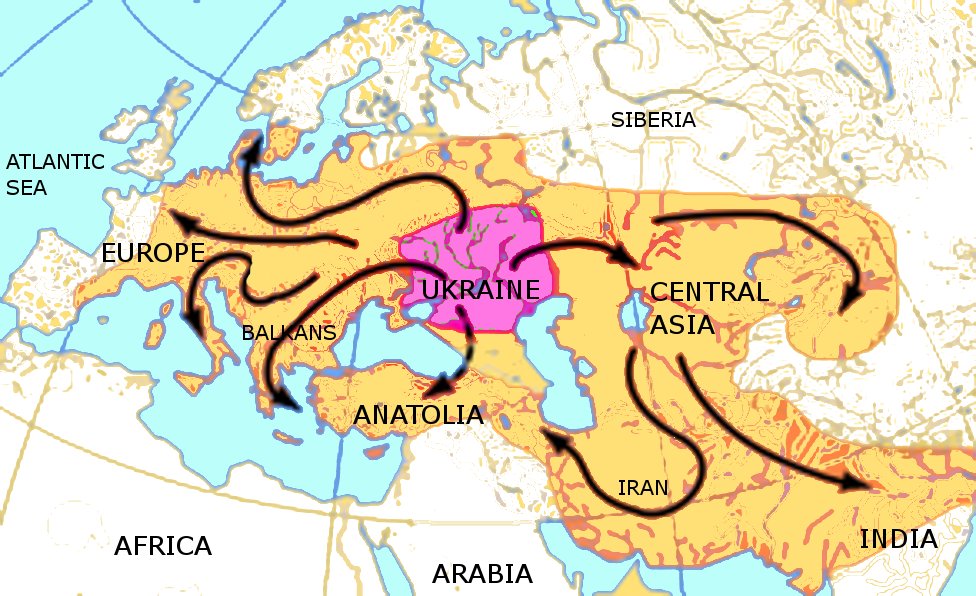Communication among humans is essential, and as we evolved, we have come to master the art of speaking. Through time and research, linguists have come to the conclusion that, because many languages from Europe and Asia share multiple similarities in vocabulary, there must have been a language from which these languages originally derived. The fact that a single language can develop into two or more different languages is due to language change.1 This language change through Europe and Asia refers to the Indo-European languages. These Indo-European languages are believed to have derived from an ancestral language known as Proto-Indo-European, which is no longer spoken.2 Because these native speakers left no evidence of writing, linguists have yet to solve when this language branched out to the various Indo-European languages we know today.

There are ten major branches to the Indo-European family of languages: Tocharian, Indo-Iranian, Hellenic, Armenian, Balto-Slavic, Albanian, Celtic, Italic, Germanic, and Anatolian. These branches also branch to other major languages, such as Russian, Polish, Spanish, German, English and many more. Words derived from the Indo-European languages are similar among each other, most commonly found in numerals from one to ten, body parts, plants, and animals.3 These findings have opened the gates for numerous researchers, including the famous philologists Sir William Jones and Franz Bopp.

Sir William Jones was an English philologist who first introduced the theory that all these languages were derived from the same language. Jones knew twenty-eight languages, which set the groundwork for his future findings. In 1786, he published The Sanskrit Language, in which he suggested that Sanskrit, Greek, and Latin shared a common root and were also related to other languages.4In 1788, he delivered a famous speech, which is considered the beginning of Indo-European language studies and comparative linguistics. Jones writes:
“The Sanskrit language, whatever be its antiquity, is of a wonderful structure; more perfect than the Greek, more copious than the Latin, and more exquisitely refined than either, yet bearing to both of them a stronger affinity, both in the roots of verbs and the forms of grammar, than could possibly have been produced by accident; so strong indeed, that no philologer could examine them all three, without believing them to have sprung from some common source, which, perhaps, no longer exists.”5
After Jones’ death, different scholars continued to investigate his findings. Franz Bopp, a German linguist, discovered the importance Sanskrit had in comparative studies of the Indo-European languages and analysed grammatical structures and compared their morphology.6 His work concentrated on tracing the origins of five different languages by focusing on their verbs. Then in 1820, he extended his studies to include grammar. Bopp’s findings resulted in the science of comparative grammar that we study today.
Although there is no literary evidence for what happened to the Proto-Indo-European native ancestors, it has been hypothesized that they migrated to different locations. As time passed, the language evolved greatly in a way that new languages began emerging, causing the original to perish. Despite the current exploration, researchers are still puzzled about the original Indo-European language, and they continue to search for answers today.

- Benjamin W. Fortson, IV, Indo-European Language and Culture: An Introduction (John Wiley & Sons, 2011), 4. ↵
- Fortson, Indo-European Language and Culture, 11. ↵
- Fortson, Indo-European Language and Culture, 41, 52, 67. ↵
- Encyclopedia of World Biography, December 2006, s.v. “William Jones Biography.” ↵
- Fortson, Indo-European Language and Culture, 9 ↵
- Franz Bopp, Analytical Comparison of the Sanskrit, Greek, Latin and Teutonic Languages, Shewing the Original Identity of Their Grammatical Structure (1820) (Amsterdam: John Benjamins Publishing, 1974), VIII). ↵



31 comments
Nooraldeen Aldrees
In the holy Quran, it mentions that “And one of His signs is the creation of the heavens and the earth, and the diversity of your languages and colors. Surely in this are signs for those of ˹sound˺ knowledge.” They diversity of language is considered a topic that is worthy of contemplating and thinking about according to the Quran. When I first heard the term Indo-European languages, it gives me confusion. I ask myself if we were talking about European languages, Indian languages, both languages combined, only European languages that are influenced by the Indian language, or neither. I hear this term a lot, but I never have a good grasp about it. Later in the article, it mentioned that Sanskrit language has commonality with Greek and Latin. I came to shape slightly better understanding about the established connection between the three languages. How that connection between these languages happen with all this massive geographical distance is a good question to ask and attempt to answer. By looking at the history of Alexander the Great, for example, this relationship is not impossible where Alexander stretched his empire to Northwestern India. It would make sense to assume that these armies passing through many different areas would create an evolution in how people communicate and speak. However, we rarely think of how language evolve when studying history of Greece, the roman empire, the Mongol empire, Ottoman empire, or any other significant time. I believe that looking at these stories, in terms of trying to analyze how people in these empires communicated, would move us to another level of understanding these eras.
Daniel Gimena
I enjoyed reading this article because as I started reading it, I noticed that I never had asked myself from where all the (most used) languages come from. It definitely makes sense that, if in a Country like the USA everyone speaks the same language, in a Continent like Europe that is smaller than the US, sometime ago everyone spoke the same, or almost the same, language. I only knew about Latin and Germanic, and the languages that have their roots in this ancient languages, but I never had thought about all the other European languages and their origins, and still less about one ancient language that could englobe them all. That is why I liked how the author presents Indo-European languages, Sir Williams Jones, Franz Bopp, The Sanskrit Language, etc.
Ryan Estes
This article was a very interesting read. So often I just think about where and how humans originated. I don’t really think about the evolution of language. I find the theory that all the Indo-European languages derived from the same language fascinating. It is fun to think about how these languages evolved from one language. Did different groups of people change parts of the Proto-Indo-European language? How exactly were the new languages different from the Proto-Indo-European language? These are a few of the questions I have after reading this engrossing article.
Luke Lopez
This was a very informative article on Indo-European languages. It is interesting that all the languages in the world have a common origin in the Proto-Indo-European language, and that linguists have not yet found any evidence of writing from this language. Overall, this was a great article that went into detail in discussing the Indo-European languages and how the languages of today share similar characteristics.
Alexander Manibusan
First of all, praise to Sir William Jones to his passion and his work. But what I find so utterly fascinating is the fact that so many languages belong to certain families and then those families can possibly be combined to form a super ancient language spoken so long ago. But I’m sure everyone would like to know what the “first” language was. If only time machines were available so that we could marvel at what proto-Indo-European sounded like.
Natalia Flores
Such an interesting topic! This is truly fascinating that the first language that is believed to have lead, called the Proto-Indo-European language, could have created modern language. It’s incredible that Sir William Jones knew 28 languages and was able to piece together certain words that had the same connections. I’ve noticed the same thing when learning German and Danish. Along with those languages, some words are similar or have the same connotations as other words in Spanish.
Anna Guaderrama
I loved reading this article, it was so interesting and insightful. Personally, I’ve made it a goal to be fluent in 6 languages by the time I graduate…so I feel like it’s safe to say I find languages interesting and important. From reading the article, I must point of that the last image really caught my attention because I feel like that really capture the main idea and cleared up any questions.
Josemaria Soriano
I found this a very interesting article. I am learning by myself Russian, and something that surprised me was that there were many words in Russian that looked a lot like their translation into Spanish. This similarity is logical when you contrast French with Spanish, or Italian with Portuguese. However, when you contrast a Slavic language with a romantic one, any similarity is very shocking. I am of the supporters who believe that there should be a single standard language for the whole world. Many opponents consider that a single language would affect culture. But this is false, because anyone has the possibility of being bilingual if they are taught at an early age. On the other hand, as a Spanish speaker I can testify that, although all the countries of Central and South America speak the same language, each one has a different accent, diversity that enriches the Latin culture. In the same way, having a common language would not affect the culture because the emphasis on the language will be part of the culture. What language should the world use? Indo-European, because it is the language, as we could see in the article, with the best grammar and with the most words similar to conventional languages of today.
Oceane Roux
Thank you for this article! I love learning about languages and before reading this article I thought that Latin and Greek were the absolute “origins” of the European languages. I would have never had thought that these two would be based on the same language. Furthermore, I really liked the last picture “Indo-European Family Tree” that illustrate perfectly the hypothesis of the existence of a first common language.
Mario Sosa
It is truly incredible how so many languages all come from the Proto-Indo-European language. Possibly even more incredible is how Sir William Jones was able to learn 28 languages. The family tree chart was extremely helpful in seeing a lot of well known languages branch out into more branches. All of this makes me wonder how the Indo-European language sounded like. Fascinating article, great job!